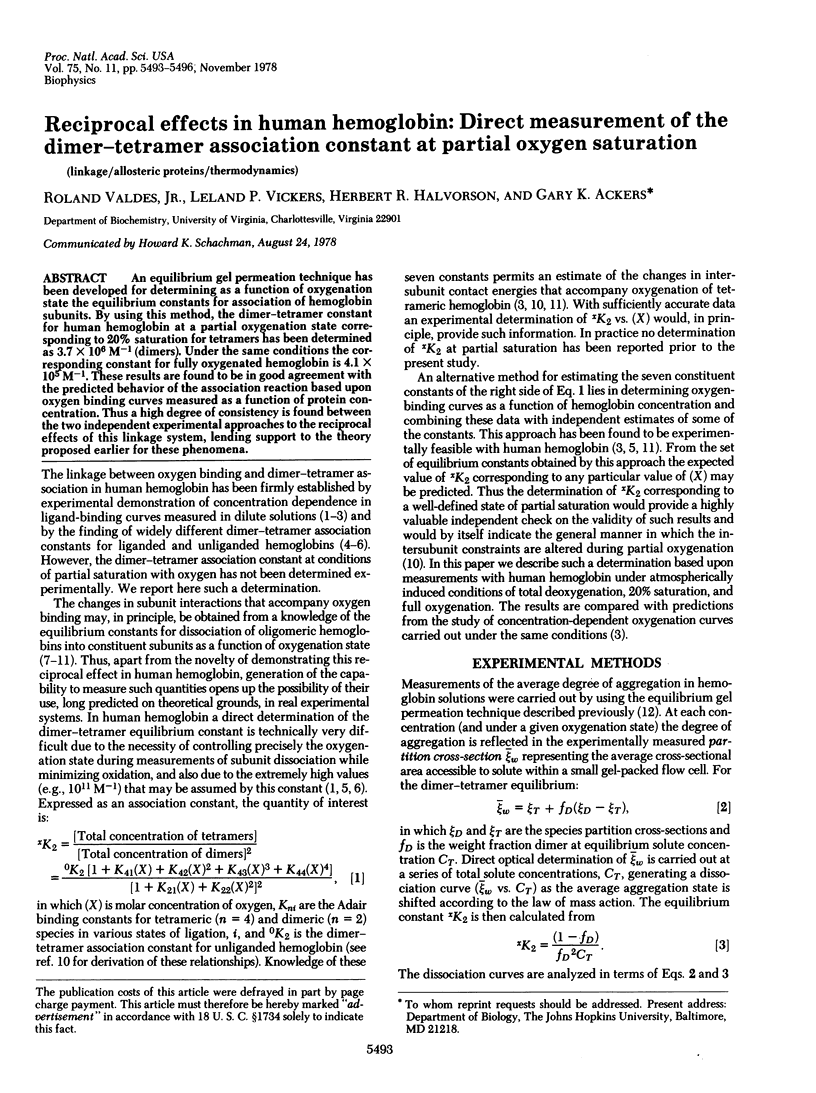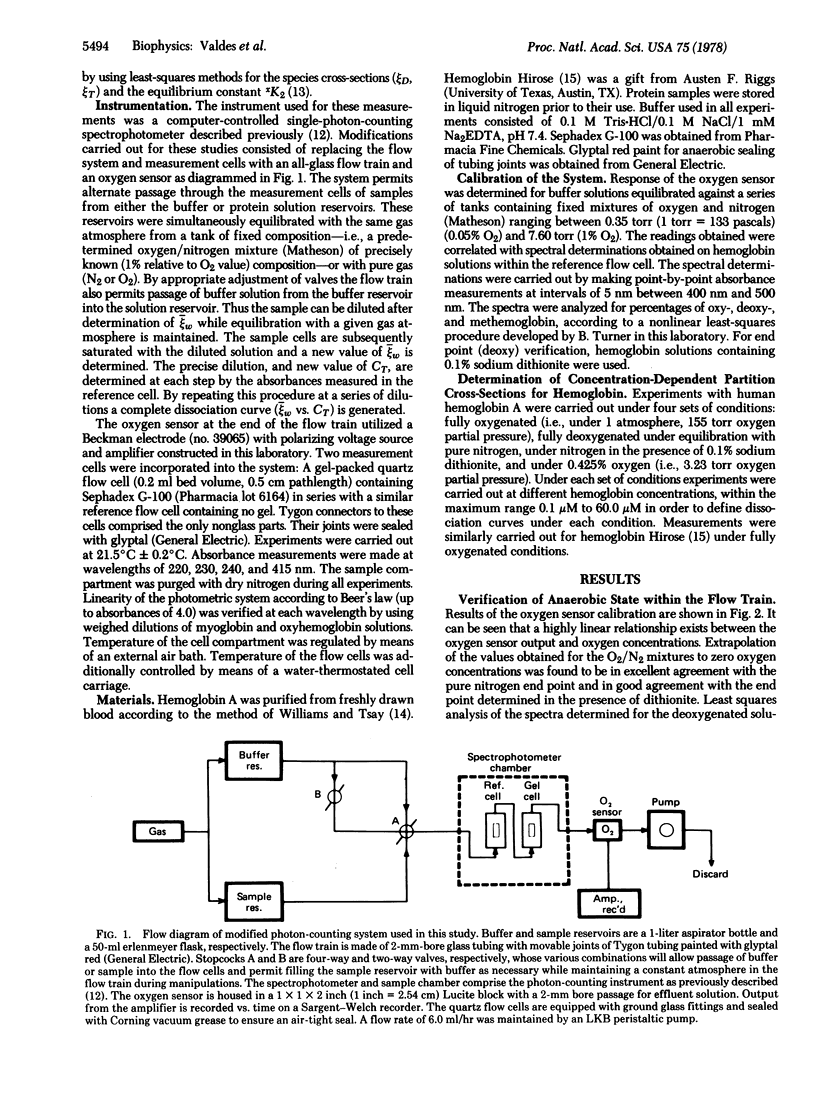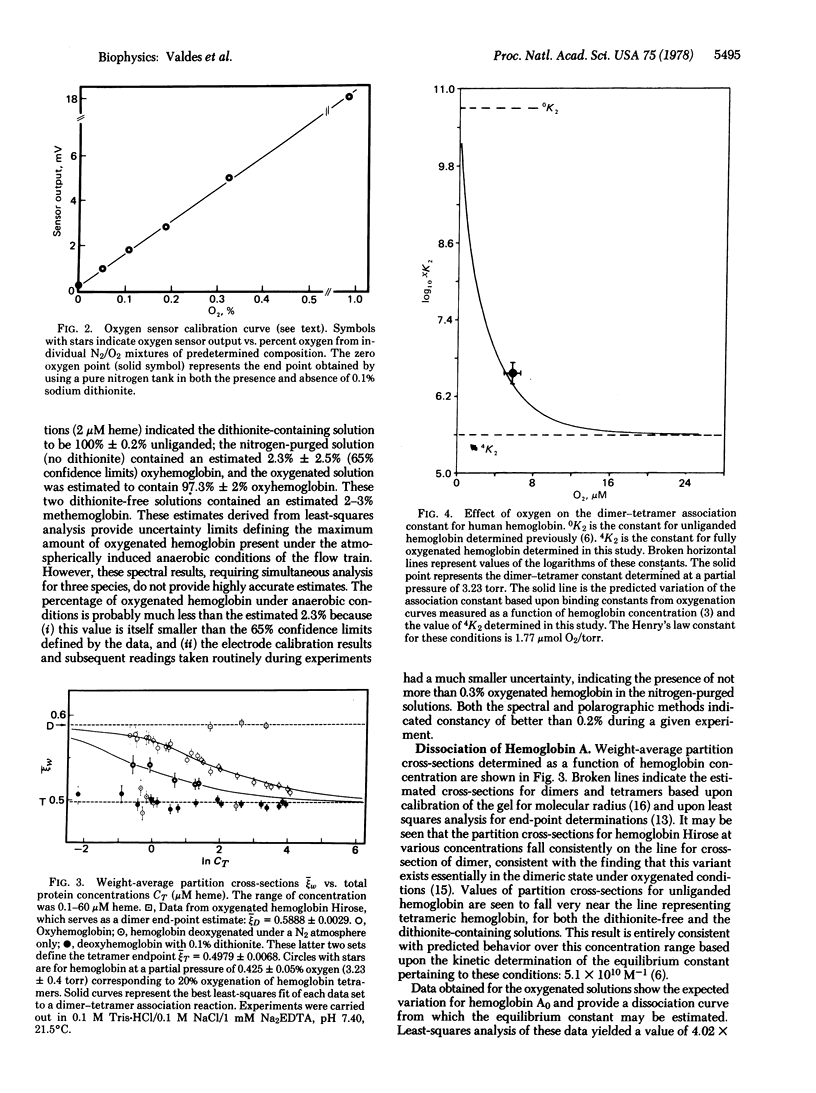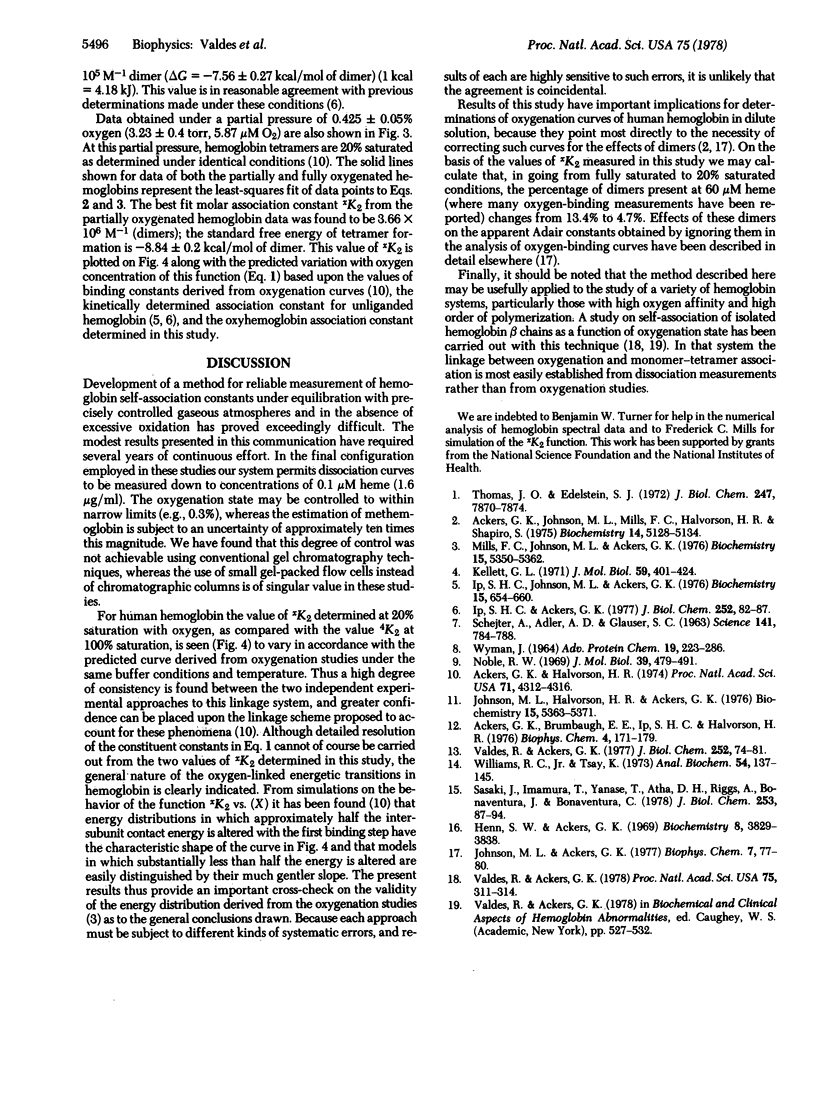Abstract
An equilibrium gel permeation technique has been developed for determining as a function of oxygenation state the equilibrium constants for association of hemoglobin subunits. By using this method, the dimer-tetramer constant for human hemoglobin at a partial oxygenation state corresponding to 20% saturation for tetramers has been determined as 3.7 X 10(6) M-1 (dimers). Under the same conditions the corresponding constant for fully oxygenated hemoglobin is 4.1 X 10(5) M-1. These results are found to be in good agreement with the predicted behavior of the association reaction based upon oxygen binding curves measured as a function of protein concentration. Thus a high degree of consistency is found between the two independent experimental approaches to the reciprocal effects of this linkage system, lending support to the theory proposed earlier for these phenomena.
Full text
PDF



Selected References
These references are in PubMed. This may not be the complete list of references from this article.
- Ackers G. K., Brumbaugh E. E., Ip S. H., Halvorson H. R. Equilibrium gel permeation: a single-photon counting spectrophotometer for studies of protein interaction. Biophys Chem. 1976 Mar;4(2):171–179. doi: 10.1016/0301-4622(76)85007-7. [DOI] [PubMed] [Google Scholar]
- Ackers G. K., Halvorson H. R. The linkage between oxygenation and subunit dissociation in human hemoglobin. Proc Natl Acad Sci U S A. 1974 Nov;71(11):4312–4316. doi: 10.1073/pnas.71.11.4312. [DOI] [PMC free article] [PubMed] [Google Scholar]
- Ackers G. K., Johnson M. L., Mills F. C., Halvorson H. R., Shapiro S. The linkage between oxygenation and subunit dissociation in human hemoglobin. Consequences for the analysis of oxygenation curves. Biochemistry. 1975 Nov 18;14(23):5128–5134. doi: 10.1021/bi00694a017. [DOI] [PubMed] [Google Scholar]
- Henn S. W., Ackers G. K. Molecular sieve studies of interacting protein systems. V. Association of subunits of D-amino acid oxidase apoenzyme. Biochemistry. 1969 Sep;8(9):3829–3838. doi: 10.1021/bi00837a049. [DOI] [PubMed] [Google Scholar]
- Ip S. H., Ackers G. K. Thermodynamic studies on subunit assembly in human hemoglobin. Temperature dependence of the dimer-tetramer association constants for oxygenated and unliganded hemoglobins. J Biol Chem. 1977 Jan 10;252(1):82–87. [PubMed] [Google Scholar]
- Ip S. H., Johnson M. L., Ackers G. K. Kinetics of deoxyhemoglobin subunit dissociation determined by haptoglobin binding: estimation of the equilibrium constant from forward and reverse rates. Biochemistry. 1976 Feb 10;15(3):654–660. doi: 10.1021/bi00648a032. [DOI] [PubMed] [Google Scholar]
- Johnson M. L., Ackers G. K. Resolvability of Adair constants from oxygenation curves measured at low hemoglobin concentration. Biophys Chem. 1977 Jun;7(1):77–80. doi: 10.1016/0301-4622(77)87017-8. [DOI] [PubMed] [Google Scholar]
- Johnson M. L., Halvorson H. R., Ackers G. K. Oxygenation-linked subunit interactions in human hemoglobin: analysis of linkage functions for constituent energy terms. Biochemistry. 1976 Nov 30;15(24):5363–5371. doi: 10.1021/bi00669a024. [DOI] [PubMed] [Google Scholar]
- Kellett G. L. Dissociation of hemoglobin into subunits. Ligand-linked dissociation at neutral pH. J Mol Biol. 1971 Aug 14;59(3):401–424. doi: 10.1016/0022-2836(71)90307-x. [DOI] [PubMed] [Google Scholar]
- Mills F. C., Johnson M. L., Ackers G. K. Oxygenation-linked subunit interactions in human hemoglobin: experimental studies on the concentration dependence of oxygenation curves. Biochemistry. 1976 Nov 30;15(24):5350–5362. doi: 10.1021/bi00669a023. [DOI] [PubMed] [Google Scholar]
- Noble R. W. Relation between allosteric effects and changes in the energy of bonding between molecular subunits. J Mol Biol. 1969 Feb 14;39(3):479–491. doi: 10.1016/0022-2836(69)90139-9. [DOI] [PubMed] [Google Scholar]
- SCHEJTER A., ADLER A. D., GLAUSER S. C. STOICHIOMETRY OF HEMOGLOBIN REACTIONS. Science. 1963 Aug 30;141(3583):784–788. doi: 10.1126/science.141.3583.784. [DOI] [PubMed] [Google Scholar]
- Sasaki J., Imamura T., Yanase T. Hemoglobin Hirose, a human hemoglobin variant with a substitution at the alpha1beta2 interface. Subunit dissociation and the equilibria and kinetics of ligand binding. J Biol Chem. 1978 Jan 10;253(1):87–94. [PubMed] [Google Scholar]
- Thomas J. O., Edelstein S. J. Observation of the dissociation of unliganded hemoglobin. J Biol Chem. 1972 Dec 25;247(24):7870–7874. [PubMed] [Google Scholar]
- Valdes R., Jr, Ackers G. K. Self-association of hemoglobin betaSH chains is linked to oxygenation. Proc Natl Acad Sci U S A. 1978 Jan;75(1):311–314. doi: 10.1073/pnas.75.1.311. [DOI] [PMC free article] [PubMed] [Google Scholar]
- Valdes R., Jr, Ackers G. K. Thermodynamic studies on subunit assembly in human hemoglobin. Self-association of oxygenated chains (alphaSH and betaSH): determination of stoichiometries and equilibrium constants as a function of temperature. J Biol Chem. 1977 Jan 10;252(1):74–81. [PubMed] [Google Scholar]
- WYMAN J., Jr LINKED FUNCTIONS AND RECIPROCAL EFFECTS IN HEMOGLOBIN: A SECOND LOOK. Adv Protein Chem. 1964;19:223–286. doi: 10.1016/s0065-3233(08)60190-4. [DOI] [PubMed] [Google Scholar]
- Williams R. C., Jr, Tsay K. Y. A convenient chromatographic method for the preparation of human hemoglobin. Anal Biochem. 1973 Jul;54(1):137–145. doi: 10.1016/0003-2697(73)90256-x. [DOI] [PubMed] [Google Scholar]


